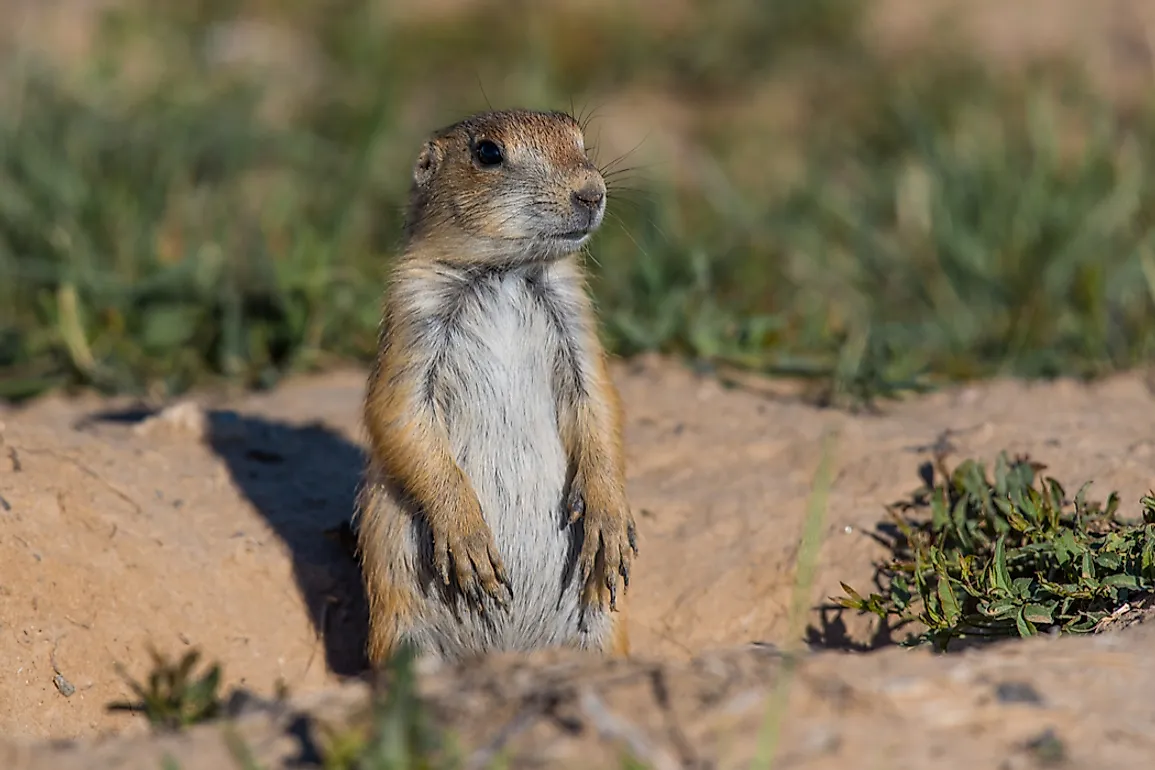Black-Tailed Prairie Dog: Animals of North America

5. Physical Description
Black Tailed Prairie Dogs (Cynomys ludovicianus) are members of the Squirrel Family, Sciuridae. The defining characteristic of this family group is that hey are small- to medium-sized rodents, and it includes chipmunks as well. They are located across the Great Plains that cover North America from Mexico to Canada. Black-Tailed prairie dogs, much like their name alludes to, have black tails, as well as tan bodies with lighter underbellies. Their lengths range from 14 to 17 inches as adults, with mature weight ranges from 1.5 to 3 pounds. There are no strong discerning characteristics that separate the sexes, although males are generally heavier than females. Their coats molt twice a year when the seasons change, with the summer coats being lighter versions than the winter ones.
4. Diet
Black-tailed prairie dogs are among the pickier eaters in the Animal Kingdom. They are very particular about the stages they eat different plants at, and they adapt their diets to the changing of the seasons. In the winter, they rarely venture from out of their underground burrows, so they prefer to dine upon underground roots at that time. During the summer months, most of their diet is made up of different grasses. They get a lot of their hydration from plants as well, especially from the plains prickly pear. Grassy plants make up the largest part of their diet, supplemented with seeds, roots, and insects like grasshoppers.
3. Habitat and Range
Their conservation status has them listed as a species of "Least Concern", indicating that they are at a very healthy population level. Black-tailed prairie dogs used to span throughout much more of North America than they do today, from Mexico to Canada. They can still be found in Mexico, the US, and Canada, though their populations are much smaller and their habitats fragmented. Because their habitats are grasslands which are used for farming, they have suffered a lot of habitat destruction. They live in prairies spanning across the western half of the continent, making their homes underground. This is probably why it is important for them to have flat land above them to serve as their roofs. The biggest threat to prairie dogs is destruction of their habitats to be converted for farm use. They are considered a keystone species because they play such a vital role within their ecosystems. Their burrows provide homes to different species of other animals, including black-footed ferrets, burrowing owls, and tiger salamanders. Many different species count on them as an important food source to keep their own populations stable. These predators includes coyotes, eagles, and the very same black-footed ferret species that shares their home with them.
2. Behavior
Rodents are known for their playful and curious personalities, and black-tailed prairie dogs are no exception to this. They are very social and affectionate animals, They live in family units called coteries, usually comprised by one male, a couple of females, and their offspring. These coteries live in large groups combining to create large prairie dog colonies in burrows underground. These burrows are very complex, with different areas dedicated as nurseries, for sleeping, for eating, and those for eliminating waste. There are different openings to the burrows, usually with "look out" rooms near the exits where Black-tailed prairie dogs can keep guard of activity outside. They communicate with each other through sounding off different barks signifying different predators. They also communicate by giving each other so called prairie dog "kisses", a form of nuzzling used when greeting one another.
1. Reproduction
Black-tailed prairie dog females start to go into heat in March. At this time, Black-tailed prairie dogs proceed to mate underground, with their mating season ending at the beginning of May. The females are pregnant for a period of 33 to 38 days, with all of their pups being born by the end of May. There are usually 3 to 4 pups within a littler, but Black-tailed prairie dog have been known to give birth to up to 8 pups within a single litter.











